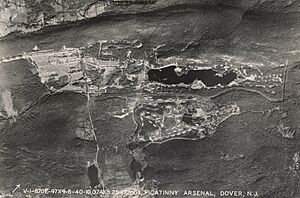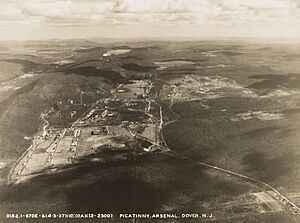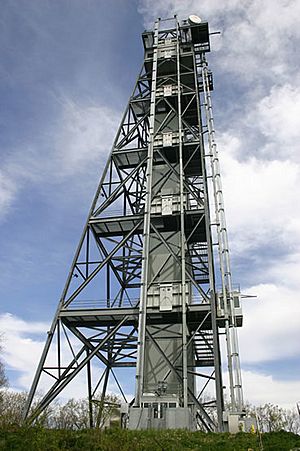Picatinny Arsenal facts for kids
 |
|
| Government owned | |
| Industry | Firearms |
| Predecessor | Picatinny Powder Depot |
| Founded | September 6, 1880 |
| Headquarters |
,
United States
|
|
Area served
|
North America |
| Products | Weapons, gunpowder, munitions, military systems |
Picatinny Arsenal is a special place where the United States Army develops and makes weapons and other military gear. It covers a large area of land in Morris County, New Jersey, near Picatinny Lake. This facility is the main center for the US Army's work on armaments.
It's famous for creating the Picatinny rail, which is a common part on many firearms. This rail helps soldiers attach different accessories like scopes or lights to their weapons. Picatinny Arsenal is also the Army's expert center for small arms ammunition.
The facility started in 1880 as the Picatinny Powder Depot. It first made gunpowder. After World War I, it began making larger weapons and doing more research and development. During World War II, it was a huge factory, employing 18,000 people to load large-caliber rounds. Today, Picatinny Arsenal creates new technologies for the US Armed Forces and produces various munitions, weapons, and armor systems.
Picatinny Arsenal is also home to the US Army Explosive Ordnance Disposal Technology Directorate. This group creates tools and methods for Army bomb disposal teams. They have invented things like weapons on robot platforms, including the SWORDS robot.
Contents
History of Picatinny Arsenal
Before the American Civil War, the US Army stored gunpowder in many places. Many of these storage sites were in the South. When the war began, these sites were taken by the Confederate States of America. So, the government needed a new, central storage place in the Northeast.
The United States War Department opened the Dover Powder Depot on September 6, 1880. Just four days later, its name changed to the "Picatinny Powder Depot." The name "Picatinny" comes from a Lenape word. It means "rugged cliff by water" or "water by the hills."
The government bought the first land for the arsenal in 1880. This area was chosen because it was in a valley between hills. These hills could help protect the surrounding areas from accidental explosions.
In 1907, the Army changed the name to "Picatinny Arsenal." They built their first powder factory there. While still making munitions, the arsenal also started focusing on research and development. They opened a school for officers in 1911 to teach them about weapons. They also started testing labs during World War I. In 1919, they began designing and developing artillery ammunition. By 1921, they were also in charge of experimental work on fuzes.
The 1926 Lake Denmark Fire
On July 10, 1926, a lightning strike hit a Navy ammunition warehouse. This started a huge fire. Millions of pounds of explosives blew up over two or three days. This caused massive damage to buildings and resulted in military and civilian injuries. The value of the destroyed ammunition was like a billion dollars today.
Because of this event, Congress created the Armed Forces Explosives Safety Board. This board now oversees all explosives used by the US Armed Forces. This event also led to the creation of a new, safe ammunition depot on the West Coast.
Innovations and Growth
Between World War I and World War II, Picatinny Arsenal continued to grow as a research center. They found better ways to store smokeless powder. They also improved how they processed cyclonite, also known as RDX. A new explosive called haleite, later known as Ednatol, was also discovered here.
Just before World War II in 1941, the Army bought more land. This included a small village called Spicertown. During World War II, Picatinny Arsenal became a major manufacturing site. It employed 18,000 people. They worked three shifts to produce bombs and artillery shells. Even then, they had research successes. They developed special bombs for dams and oil fields.
After World War II, Picatinny focused again on creating new weapons and munitions. They helped American forces in Korea with an improved bazooka. During peacetime, they made important advances in radar, pyrotechnics, missiles, and nuclear munitions. This included the "Atomic Annie" cannon.
When the Vietnam War started, Picatinny provided troops with different types of 40 mm ammunition. This ammunition was used for grenade launchers and helicopter gunships.
In 1977, the Army recognized Picatinny's leadership. They made it the headquarters for the Armament Research and Development Command (ARRADCOM). This gave Picatinny responsibility for developing small weapons and ammunition. The name of the center changed a few times over the years. In 2019, it became the Combat Capabilities Development Command - Armaments Center (CCDC-AC).
The Picatinny Rail
In 1992, Picatinny Arsenal was asked to develop a standard system for attaching accessories to weapons. A team led by Gary Houtsma worked on this. He measured many different existing rail products. He then created a standard design. This design was similar to rails already used on 105 mm howitzers.
This new standard was adopted in 1995. It is known as MIL-STD-1913. This is why it's called the Picatinny rail.
Picatinny Arsenal continues to innovate. In 2010, they developed the M855A1 EPR round. This is an improved, environmentally friendly version of the M855 5.56x45mm ammunition. In 2014, Picatinny Arsenal had its first all-female command team.
Lake Denmark Powder Depot
In 1891, the Navy took over some land from the arsenal. They created the Lake Denmark Powder Depot there. This later became the "Lake Denmark Naval Ammunition Depot." As mentioned earlier, a lightning strike caused a huge explosion here in 1926. This event led to new safety rules for explosives. In 1960, the Army took back control of this land. This made the installation its current size.
Transportation at the Arsenal
In its early days, most transportation at Picatinny Arsenal was by train. A railroad line ran through the valley where the arsenal is located. Picatinny had many miles of its own railway tracks. These tracks moved fuel, raw materials, and ammunition to different buildings. Today, the train service is mostly a memory. Only a few unused tracks remain. Some old tracks have even been covered and turned into walking paths.
Picatinny's Future Role
In 2005, the Department of Defense decided that Picatinny would be the main site for guns and ammunition. This decision meant that experts from other Navy facilities would move to Picatinny. The goal was to bring together all the research, development, and acquisition work for guns and ammunition. Picatinny Arsenal is now the main center for this work. It also manages all conventional ammunition for the Department of Defense.
Environmental Efforts
| Picatinny Arsenal | |
|---|---|
| Superfund site | |

Aerial view of Picatinny Arsenal
|
|
| Geography | |
| Township | Rockaway |
| County | Morris |
| State | New Jersey |
| Lua error in Module:Location_map at line 420: attempt to index field 'wikibase' (a nil value). | |
| Information | |
| CERCLIS ID | NJ3210020704 |
| Responsible parties |
United States Army |
| Progress | |
| Proposed | July 14, 1989 |
| Listed | February 21, 1990 |
| List of Superfund sites | |
Since 1976, the Army has studied the environment at Picatinny. In 1990, it was listed as a superfund site. This means it needs special cleanup efforts. Picatinny has a group that meets regularly to discuss these environmental efforts. They also hold public meetings to keep everyone informed.





